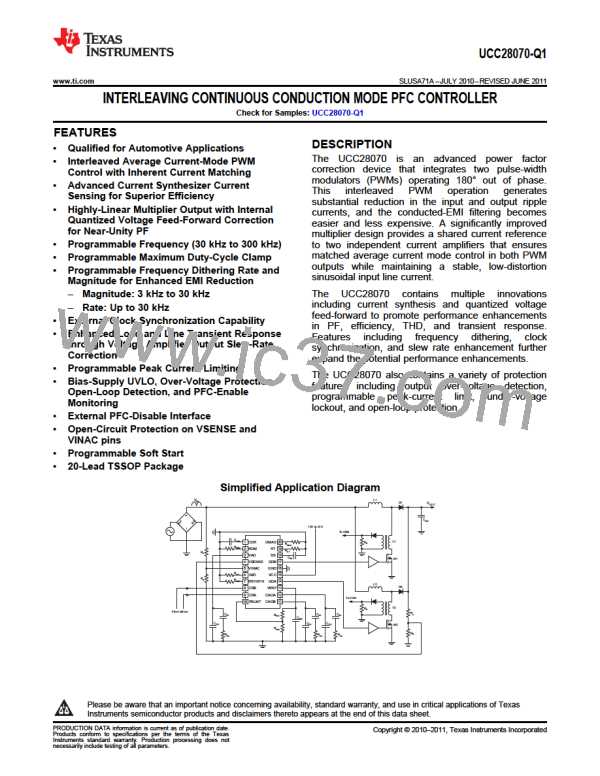UCC28070-Q1
www.ti.com
SLUSA71A –JULY 2010–REVISED JUNE 2011
The multiplier output current IIMO for any line and load condition can thus be determined by the equation
17mA´ V
(
´ V -1
VAO
) (
kVFF
)
VINAC
IIMO
=
(13)
2
Because the kVFF value represents the scaled VRMS at the center of a level, VVAO will adjust slightly upwards or
downwards when VINACpk is either lower or higher than the center of the QVFF voltage range to compensate for
the difference. This is automatically accomplished by the voltage loop control when VIN varies, both within a level
and after a transition between levels.
The output of the voltage-error amplifier VAO is clamped at 5.0 V, which represents the maximum PFC output
power. This value is used to calculate the maximum reference current at the IMO pin, and sets a limit for the
maximum input power allowed (and, as a consequence, limits maximum output power).
Unlike a continuous VFF situation, where maximum input power is a fixed power at any VRMS input, the discrete
QVFF levels permit a variation in maximum input power within limited boundaries as the input VRMS varies within
each level.
The lowest maximum power limit occurs at the VINAC voltage of 0.76 V, while the highest maximum power limit
occurs at the increasing threshold from level-1 to level-2. This pattern repeats at every level transition threshold,
keeping in mind that decreasing thresholds are 95% of the increasing threshold values. Below VINAC = 0.76 V,
PIN is always less than PIN(max), falling linearly to zero with decreasing input voltage.
For example, to design for the lowest maximum power allowable, determine the maximum steady-state (average)
output power required of the PFC pre-regulator and add some additional percentage to account for line drop-out
recovery power (to recharge COUT while full load power is drawn) such as 10% or 20% of POUT(max). Then apply
the expected efficiency factor to find the lowest maximum input power allowable:
1.10´ P
OUT(max)
P
=
IN(max)
h
(14)
At the PIN(max) design threshold, VVINAC = 0.76 V, hence QVFF = 0.398 and input VAC = 73 VRMS (accounting for
2-V bridge-rectifier drop) for a nominal 400-V output system.
P
IN(max)
Thus IIN( rms )
=
,and IIN( pk ) =1.414´ IIN( rms )
73VRMS
(15)
Copyright © 2010–2011, Texas Instruments Incorporated
23

 TI [ TEXAS INSTRUMENTS ]
TI [ TEXAS INSTRUMENTS ]